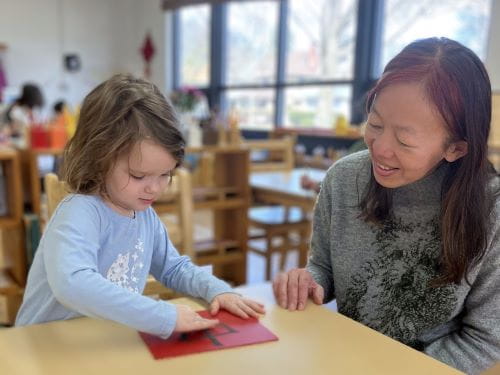“Buenos días! Ohayō! Zǎoshang hǎo!” echo joyfully throughout the halls each morning as students arrive and enter their dual language, Montessori communities where they are learning both English and a target language—Spanish, Chinese Mandarin, or Japanese. Over the past decade, I have become convinced that a dual language, Montessori education is one of the best gifts we can give our children. Maria Montessori’s belief that “Establishing lasting peace is the work of education” takes on new life and meaning in the walls of these classrooms.
 Anyone who steps into a Montessori classroom is quickly able to observe the important role language plays. Montessori’s fundamental belief in the connection between the hand and the brain, which guided the creation of the Montessori materials, provides the perfect support for learning language. Materials like the Sandpaper Letters leave lasting impressions as students learn sounds associated with letters and characters. The use of pictures and objects to represent words builds connection between a word and what it represents. All of these countless built in tools for learning language can be quickly applied to learning more than one language under a curriculum that is already carefully aligned with a child’s development. While a language like Chinese Mandarin is fundamentally different from English, it is equally supported by the materials, allowing children to experience language in a rich, supported way. For example, our classrooms are equipped with sandpaper letters, moveable alphabets, vocabulary work, etc. in both English and the target language.
Anyone who steps into a Montessori classroom is quickly able to observe the important role language plays. Montessori’s fundamental belief in the connection between the hand and the brain, which guided the creation of the Montessori materials, provides the perfect support for learning language. Materials like the Sandpaper Letters leave lasting impressions as students learn sounds associated with letters and characters. The use of pictures and objects to represent words builds connection between a word and what it represents. All of these countless built in tools for learning language can be quickly applied to learning more than one language under a curriculum that is already carefully aligned with a child’s development. While a language like Chinese Mandarin is fundamentally different from English, it is equally supported by the materials, allowing children to experience language in a rich, supported way. For example, our classrooms are equipped with sandpaper letters, moveable alphabets, vocabulary work, etc. in both English and the target language.
There is little debate anymore as to whether there are neurological benefits to knowing more than one language; this is quite clear after decades of research. Our understanding of these benefits only continues to deepen through studies and enhanced technology that allows us to examine and compare images of the brain showing that being bilingual actually changes your brain, increasing the connection between its four lobes. This research also points to an improvement in other skills—memory, concentration, communication, as well as overall academic achievement.
Can you learn another language as an adult? Absolutely. However, you’re likely going to have to work a lot harder and may never achieve a nativelike mastery of that language. Montessori spoke often about how language learning is both spontaneous and natural for a young child. Language development undergoes explosive growth in the early years followed by a period of refinement that is supported through the Montessori curriculum. When a child learns more than one language during this time, the same principles apply. While vast benefits exist for anyone that seeks to learn another language, it is undeniably advantageous to start as a child.
In addition to these neurological benefits, knowing two or more languages creates a connection between people and cultures that would not otherwise exist. Classroom communities that are centered around culture and diversity encourage students to thrive in new environments and see themselves as citizens of the world. When teachers are native speakers of the target language they teach, they are able to infuse their classroom with first hand cultural experiences, enhancing the already strong connection Montessori classrooms have to representing cultures from across the globe. This daily exposure to other cultures and traditions reshapes a student’s view of the world, an important component of our anti bias, antiracist work as educators. As a student learns another language, empathy and understanding of others learning language is also developed. An individual who learns to bridge gaps between language and culture is poised to be a peacemaker, bringing meaningful change to the world.
I first encountered dual language, Montessori education when I began teaching in a Lower Elementary classroom about ten years ago and cannot imagine a more vibrant, dynamic environment for learning. I have had the joy of watching my three children, all wildly different, each thrive in their dual language Montessori classrooms as well. In the past few years, I’ve shifted my focus to administration and have the privilege of sitting with families to talk about their hopes and dreams for their own child as they begin their Montessori journey as well as walking alongside teachers who are truly shaping the future of the world. Please share your dual language, Montessori questions, struggles, and triumphs with me at sness@interculturalmontessori.org and follow us at intercultural_montessori.
Interested in writing a guest post for our blog? Let us know!
The opinions expressed in Montessori Life are those of the authors and do not necessarily represent the position of AMS.


